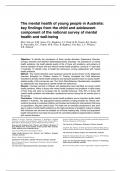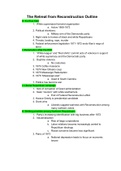The mental health of young people in Australia:
key findings from the child and adolescent
component of the national survey of mental
health and well-being
M.G. Sawyer, F.M. Arney, P.A. Baghurst, J.J. Clark, B.W. Graetz, R.J. Kosky,
B. Nurcombe, G.C. Patton, M.R. Prior, B. Raphael, J.M. Rey, L.C. Whaites,
S.R. Zubrick
Objective: To identify the prevalence of three mental disorders (Depressive Disorder,
Conduct Disorder and Attention-Deficit/Hyperactivity Disorder), the prevalence of mental
health problems, the health-related quality of life of those with problems, and patterns of
service utilisation of those with and without mental health problems, among 4–17-year-olds
in Australia. To identify rates of health-risk behaviours among adolescents with mental
health problems.
Method: The mental disorders were assessed using the parent-version of the Diagnostic
Interview Schedule for Children Version IV. Parents completed the Child Behaviour
Checklist to identify mental health problems and standard questionnaires to assess health-
related quality of life and service use. The Youth Risk Behaviour Questionnaire completed
by adolescents was employed to identify health-risk behaviours.
Results: Fourteen percent of children and adolescents were identified as having mental
health problems. Many of those with mental health problems had problems in other areas
of their lives and were at increased risk for suicidal behaviour. Only 25% of those with
mental health problems had attended a professional service during the six months prior to
the survey.
Conclusion: Child and adolescent mental health problems are an important public health
problem in Australia. The appropriate balance between funding provided for clinical inter-
ventions focusing on individual children and families and funding for interventions that focus
on populations, requires careful study. The latter are an essential component of any strat-
egy to reduce mental health problems as the high prevalence of problems makes it unlikely
that individual care will ever be available for all those needing help. Clinical and population
health interventions must take into account the comorbid problems experienced by children
with mental disorders.
Michael G Sawyer, Professor, Department of Paediatrics, Adelaide George C. Patton, Professor, Centre for Adolescent Health, Margot R. Prior,
University, Australia (Correspondence); Jennifer Clark, Project Officer; Professor, Department of Psychology
Brian Graetz, Project Manager; Leanne Whaites, Research Assistant
Research and Evaluation Unit, Women’s and Children’s Hospital, 72 The University of Melbourne, Melbourne, Victoria, Australia
King William Road, North Adelaide, South Australia 5006, Australia.
Email: Joseph M. Rey, Director of Child and Adolescent Mental Health Service,
Northern Sydney Health, Professor, Department of Psychological Medicine
Fiona Arney, PhD student; Peter Baghurst, Head
Public Health Research Unit, Women’s and Children’s Hospital, The University of Sydney, Sydney, New South Wales, Australia
Adelaide, Australia
Stephen R. Zubrick, Head, Division of Population Science, TVW Telethon
Robert J. Kosky, Emeritus Professor Institute for Child Health Research, and Professor
Department of Psychiatry, Adelaide University, Adelaide, Australia
Centre for Developmental Health, Curtin University of Technology,
Barry Nurcombe Professor, Department of Psychiatry; Beverley Raphael, Perth, Western Australia, Australia
Emeritus Professor
The University of Queensland, Brisbane, Queensland, Australia Received 23 January 2001; revised 1 August 2001; accepted 9 August 2001.
, M.G. SAWYER, F.M. ARNEY, P.A. BAGHURST, J.J. CLARK, B.W. GRAETZ, R.J. KOSKY, B. NURCOMBE, 807
G.C. PATTON, M.R. PRIOR, B. RAPHAEL, J.M. REY, L.C. WHAITES, S.R. ZUBRICK
Key words: adolescents, children, health-related quality of life, mental disorders, physical
disorders.
Australian and New Zealand Journal of Psychiatry 2001; 35:806–814
We describe the key findings from the Child and using a structured diagnostic interview completed by
Adolescent Component of the National Survey of Men- parents [8]. The National Collaborating Group res-
tal Health and Well-Being and their implications for ponsible for conducting the survey chose three mental
those providing mental health services to young people disorders (Depressive Disorder, Conduct Disorder and
in Australia. Previously in this journal we have described Attention-Deficit/Hyperactivity Disorder) for inclusion
the background and the methodology employed in the because; (i) they are known from previous studies to be
survey [1]. prevalent in the community (ii) they have great signifi-
While there have been several surveys of the mental cance for child and adolescent health in Australia and
health of young people in individual states of Australia (iii) they could be examined within the funding and time
[2–4], this is the first epidemiological study which constraints of the study. It was not possible to include
describes the prevalence of child and adolescent mental Anxiety Disorders as the assessment of these disorders
health problems at a national level. Previous studies have with the interview schedule employed in the survey is
included work by Connell et al. [3] in Queensland who complex and their inclusion would have required another
surveyed 986 children aged 10–11 years using the same group of disorders to be dropped. The exclusion of
methodology as that employed by Rutter et al. in the Isle Anxiety Disorders is unfortunate, because other surveys
of Wight Study [5]. Connell et al. [3] reported an overall have shown these disorders to be relatively common
prevalence of psychiatric disorder of 14%, with children among children and adolescents. It should be noted that
in rural areas having a somewhat lower prevalence of if a wider range of disorders had been investigated, a
disorders than children living in urban areas. Sawyer higher prevalence of mental disorders would have been
et al. [2] surveyed 528 children aged 10–11 years or identified in the survey.
14–15 years living in metropolitan Adelaide using the
Child Behaviour Checklist (CBCL) [6] and reported that Method
21% of children in the younger group and 15% in the
older group scored above the recommended cut-off score Participants
on the checklist. In Western Australia, Zubrick et al. [4]
surveyed 2737 children aged 4–16 years living in 1462 The participants were 4509 children aged 4–17 years. This sample
households using the CBCL and the Teacher Report size allowed for acceptable precision in prevalence estimates at a
Form (TRF) [7]. The authors reported that 18% of the national level with confidence intervals of ± 1%, assuming a preva-
lence of childhood mental disorders of approximately 15%. The lower
children had a mental health problem, defined as a score
age limit for the survey was determined by the capacity of the survey
above the recommended cut-off on either the CBCL or
instruments to provide valid and reliable ratings of the mental health
the TRF. The most frequently reported problems were on problems of younger children. The upper age limit of 17 years was
the checklist scales which identified ‘delinquency prob- determined by the lower age limit of the survey of adults.
lems’, ‘thought problems’ and ‘attention problems’ [4]. The survey utilised a multi-stage probability methodology designed
The aims of the Child and Adolescent Component of to identify participants. ‘Clusters’ of 10 fully responding households
the National Survey of Mental Health and Well-Being with children in the required age-range were sampled from each of 450
were to identify: (i) the number of children in Australia Census Collector’s Districts across Australia. The number of districts
with mental health problems (ii) the nature of these prob- sampled within each state or territory was in proportion to the size of
lems (iii) the degree of disability associated with mental the target populations within each region, and were also distributed
health problems, and (iv) the services being used by proportionately across metropolitan and nonmetropolitan areas [8].
The participation rate was 86% (this is calculated as the proportion
children with mental health problems (for brevity, in this
of households that were contacted, identified to contain a child aged
report the term ‘children’ will be used to refer to both
4–17 years, and agreed to participate). The response rate was 70% (this
children and adolescents). The survey also examined the also takes into account the number of noncontacted households esti-
prevalence among adolescents of behaviours harmful to mated to contain a child between the ages of 4 and 17 years). The
health and their association with mental health problems. major factor that affected the response rate was the replacement of
Mental health problems were identified by parents and households before the interviewers completed the specified number of
adolescents using standard behaviour checklists [8]. The callbacks. To assess for sample bias we compared the demographic
prevalence of childhood mental disorders was investigated characteristics of children, parents and families who participated in the





